

Consider these two photos, named palm tree 1.jpg and palm tree 2.jpg: Loading photos and checking them for EXIF data
#Exiftool command line update attribute install#
If you’re not maintaining any Python 2 code but have to use pip3 to install Python packages, you should consider upgrading your Python installation. pip3 is the version of pip, the Python package manager, that is specifically for Python 3. If entering this command gave you an error message, try using the command pip3 install exif instead. To install exif, use pip by entering the following on the command line: pip install exif Its API is so Pythonic that it feels almost as if it’s part of the language rather than a module. There are a number of Python modules that can access the EXIF data in digital photos. Along the way, you’ll use not just your programming skills, but you’ll do some detective work as well! The exif Module They’ll cover a couple of Python packages that you can incorporate into your applications to extract, add, alter, or erase EXIF data from photos. If you have Python 3.6 or later installed on your computer, you can find out through the hands-on exercises below.

How can I alter, add, or erase EXIF metadata programmatically?.How can I programmatically detect and read the EXIF metadata from a photo?.You’re probably aware of more recent stories where law enforcement has been arresting suspects using photos posted to a social media site that didn’t take the precaution of “scrubbing” their EXIF data during the upload process.īeing the security-conscious developers that I suspect you are, you’re probably asking yourself questions like these: That data gave away his location and led to his arrest. One journalist who was lucky enough to get an interview decided to show off his good fortune by posting a photo of McAfee without first removing its EXIF data. This was an exciting time in McAfee’s life, as he was evading law enforcement while still granting exclusive, much sought-after interviews to journalists. One of the earliest cautionary tales about EXIF is the 2012 privacy incident involving antivirus company founder John McAfee. However, it also introduces privacy and security concerns that many users don’t take into account. This metadata is useful for sorting, cataloging, and searching through photos, which is why the EXIF standard was defined. The altitude at which the photo was taken.The orientation of the device when the photo was taken.Zoom, aperture, flash, and other camera settings when the photo was taken.The make and model of the device used to take the photo.The dimensions and pixel density of the photo.In photos, EXIF can include information such as: This metadata is stored in a format called EXIF, which is short for EXchangeable Image File format, which is a continually evolving standard for information added to digital image and sound recordings. In addition to picture data, photos taken with smartphones and modern digital cameras contain metadata, which is additional information about the photo. By default, the photos taken with these cameras can give away sensitive information, and many users are unaware that it’s happening.More people than ever have a camera that’s usually within arm’s reach.The mass adoption of smartphones - essentially portable, sensor-rich, location-aware, always-networked computers - has given us two major consequences whose effects on privacy and security aren’t yet fully understood:


 0 kommentar(er)
0 kommentar(er)
